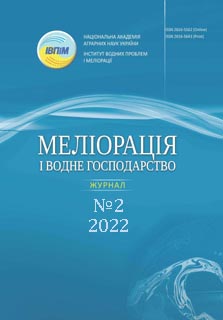OPTIMIZATION OF THE PARAMETERS OF DRIP IRRIGATION REGIMES FOR CROPS IN THE STEPPE OF UKRAINE
Abstract
The purpose of the research was to improve and substantiate the parameters of the drip irrigation regimes for crops in the Steppe of Ukraine. Field studies were carried out at the Kamyansko-Dniprovska experimental station (47046' N 34042' E), the Brylivska experimental station (46040' N 33012' E) and the Southern research station (46033' N 33059' E) from 2004 to 2021 on 11 crops. The research scheme assumed the implementation of a one-factor experiments’ series with different levels of soil humidification, the control was the variant without irrigation.
At the first stage, the mathematical dependencies "Soil moisture level (SML) –Number of vegetation irrigations" and "SML–Irrigation rate" were obtained for all crops. The establishment of correlations between the evapotranspiration of crops and their productivity is the result of the work. Based on this, were built the dependencies (statistical models) "Evapotranspiration–Productivity" and the most optimal options for using water were determined in terms of its costs for the formation of products for the drip irrigation of the Steppe of Ukraine. The given dependencies are reaction curves for a one-factor experiment, they consist of three areas: limiting, stationary and excessive. Correlation coefficients r=0,92-0,98 indicate a close relationship between these parameters. Established relationships "Evapotranspiration–Yield" from an agro biological point of view are not stable since there are potential opportunities for increasing yields with the same evapotranspiration. It has been established that the optimal moisture range for drip irrigation of most crops is a narrow range of soil moisture suction pressure of -9 to -15 kPa. This involves irrigation with small rates (50-75 m3/ha) while reducing the inter-irrigation periods. Under such conditions, the ratio of actual transpiration (Тс) to potential (То) approaches 1 (≈ 0,83-0,87), which characterizes the water supply of plants as close to optimal.
References
2. Bondarenko G.L. & Yakovenko, K.І. (2001). Methods of research in vegetable growing and melon growing Metody doslidzhen v ovochivnytstvi i bashtannytstvi []. Kharkiv: Osnova. [in Ukrainian]
3. Dudka V.V. (2013). Grain crops on drip irrigation [Zernovi kultury na kraplynnomu zroshenni]. Propozytsiia. 3-4(213-214): 72-82. [in Ukrainian]
4. Hariuhin, G.A. (1979). About optimal soil moisture [Ob optymalnoi vlazhnosty pochvy]. Bulletin of agricultural science. 7: 94-97. [in Russian]
5. Kokovikhin, S.V. & Biliaieva, I.M. (2017). Productivity and economic efficiency of growing maize hybrids depending on the methods of watering and plant protection in the South of Ukraine [Produktyvnist ta ekonomichna efektyvnist vyroshchuvannia hibrydiv kukurudzy zalezhno vid sposobiv polyvu ta zakhystu roslyn v umovakh Pivdnia Ukrainy]. Naukovi dopovidi NUBiP, 4 (168). [in Ukrainian]
6. Muromtsev, N.A. (2011). Assessment of moisture availability of plants [Otsenka vlahoobespechennosty rastenyi]. Bulletin of the Soil Institute. V.V. Dokuchaeva. 67: 20-31. [in Russian]
7. Pysarenko, V.A., Gorbatenko, E.M. & Yokych, D.R. (1988). Irrigation regimes for agricultural crops [Rezhymy zroshennia silskohospodarskykh kultur]. Kyiv. Urozhai. [in Ukrainian]
8. Romashchenko, M.I., Vozhegova, R.A. & Shatkovskyi, A.P. (2017). Scientific foundations of the agricultural sector of the economy of the Southern region of Ukraine [Naukovi osnovy ahrarnoho sektora ekonomiky v pivdennomu rehioni Ukrainy]. Kherson: Oldi-Plus. [in Ukrainian]
9. Romashchenko, M.I. at al. (2014). Metodychni rekomendatsii z provedennia doslidzhen za kraplynnoho zroshennia [Methodological recommendations for conducting research on drip irrigation]. Kyiv : DIA. [in Ukrainian]
10. Romashchenko, M.I., Koriunenko, M.M., & Muromtsev, M.I. (2012). Recommendations for operational control and management of crop irrigation regime using tensiometric method [Rekomendatsii shchodo operatyvnoho kontroliu ta upravlinnia rezhymom zroshennia kultur tenziometrychnym metodom]. Kyiv. [In Ukraine]
11. Shatkovskyi, A.P. & Zhuravlov, O.V. (2017). Scientific basis of drip irrigation of agricultural crops [Naukovi osnovy kraplynnoho zroshennia silskohospodarskykh kultur]. Odesa: Helvetika. [in Ukrainian]
12. Shatkovskyi, A.P. & Zhuravlov, O.V. (2016). Drip irrigation management based on the use of Internet weather stations iMetos® [Upravlinnia kraplynnoym zroshenniam na osnovi internet meteostantsii iMetos®]. Naukovi dopovidi NUBiP, 2 (59). [in Ukrainian]
13. Shumakov, B.A. at al. (1965). Irrigated agriculture [Oroshaemoe zemledelye]. Moscow: Rossulkhozyzdat. [in Russian]
14. Ushkarenko, V.O., Vozhehova, R.A., Holoborodko, S.P. & Kokovikhin, S.V. (2014). The methodology of field experiment: irrigation agriculture[Metodyka polovykh doslidzhen: zroshuvane zemlerobstvo]. Kherson. [in Ukrainian]


